
Darmstadt is a city in the state of Hesse in Germany, located in the southern part of the Rhine-Main-Area. Darmstadt has around 160,000 inhabitants, making it the fourth largest city in the state of Hesse after Frankfurt am Main, Wiesbaden, and Kassel.
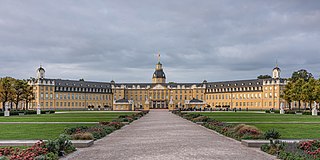
Karlsruhe is the third-largest city of the German state of Baden-Württemberg, after its capital Stuttgart and Mannheim, and the 22nd-largest city in the nation, with 308,436 inhabitants. It is also a former capital of Baden, a historic region named after Hohenbaden Castle in the city of Baden-Baden. Located on the right bank of the Rhine near the French border, between the Mannheim-Ludwigshafen conurbation to the north and Strasbourg to the south, Karlsruhe is Germany's legal center, being home to the Federal Constitutional Court, the Federal Court of Justice and the Public Prosecutor General.

Egyptian Revival is an architectural style that uses the motifs and imagery of ancient Egypt. It is attributed generally to the public awareness of ancient Egyptian monuments generated by Napoleon's invasion of Egypt in 1798, and Admiral Nelson's defeat of the French Navy at the Battle of the Nile later that year. Napoleon took a scientific expedition with him to Egypt. Publication of the expedition's work, the Description de l'Égypte, began in 1809 and was published as a series through 1826. The size and monumentality of the façades discovered during his adventure cemented the hold of Egyptian aesthetics on the Parisian elite. However, works of art and architecture in the Egyptian style had been made or built occasionally on the European continent since the time of the Renaissance.
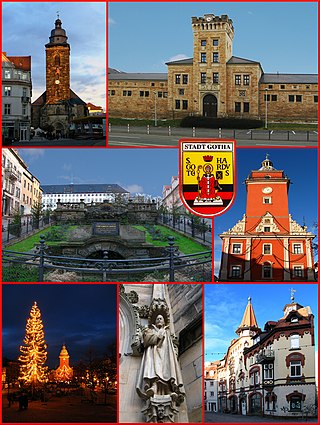
Gotha is the fifth-largest city in Thuringia, Germany, 20 kilometres west of Erfurt and 25 km east of Eisenach with a population of 44,000. The city is the capital of the district of Gotha and was also a residence of the Ernestine Wettins from 1640 until the end of monarchy in Germany in 1918. The House of Saxe-Coburg and Gotha originating here spawned many European rulers, including the royal houses of the United Kingdom, Belgium, Portugal and Bulgaria.
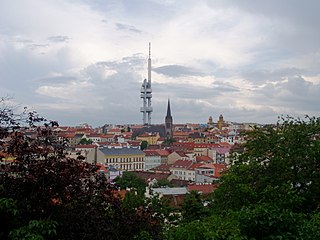
Žižkov is a cadastral district of Prague, Czech Republic.
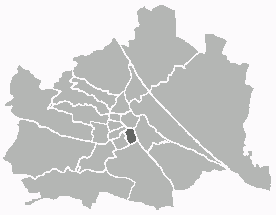
Wieden is the 4th municipal district of Vienna, Austria. It is near the centre of Vienna and was established as a district in 1850, but its borders were changed later. Wieden is a small region near the city centre. After World War II, Wieden was part of the Soviet sector of Vienna for 10 years.
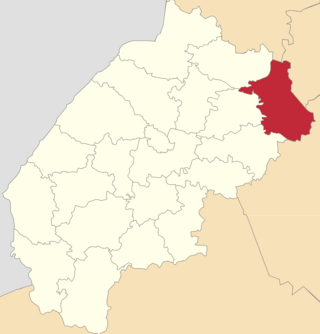
Brody Raion was a raion (district) of Lviv Oblast in western Ukraine. Its administrative center was Brody. The raion was abolished on 18 July 2020 as part of the administrative reform of Ukraine, which reduced the number of raions of Lviv Oblast to seven. The area of Brody Raion was merged into Zolochiv Raion. The last estimate of the population of the raion was 57,457.

Portuguese architecture refers to both the architecture of Portugal's modern-day territory in Continental Portugal, the Azores and Madeira, as well as the architectural heritage/patrimony of Portuguese architects and styles throughout the world, particularly in countries formerly part of the Portuguese Empire.

The architecture of Germany has a long, rich and diverse history. Every major European style from Roman to Postmodern is represented, including renowned examples of Carolingian, Romanesque, Gothic, Renaissance, Baroque, Classical, Modern and International Style architecture.

Maltese architecture has its origins in prehistory, and some of the oldest free-standing structures on Earth – a series of megalithic temples – can be found on Malta. The islands were colonized by the Phoenicians and later the Romans, who established the cities of Melite and Gaulos. Although these were substantial settlements and are known to have had numerous temples, churches and palaces, few remains have survived apart from some architectural fragments.

Mamilla is a neighbourhood of Jerusalem that was established in the late 19th century outside the Old City, west of the Jaffa Gate. Until 1948 it was a mixed Jewish–Arab business district. Between 1948 and 1967, it was located along the armistice line between the Israeli and Jordanian-held sector of the city, and many buildings were destroyed by Jordanian shelling. The Israeli government approved an urban renewal project for Mamilla, apportioning land for residential and commercial zones, including hotels and office space. The Mamilla Mall opened in 2007.

Turin is a city and an important business and cultural centre in Northern Italy. It is the capital city of Piedmont and of the Metropolitan City of Turin, and was the first Italian capital from 1861 to 1865. The city is mainly on the western bank of the Po River, below its Susa Valley, and is surrounded by the western Alpine arch and Superga hill. The population of the city proper is 847,622, while the population of the urban area is estimated by Eurostat to be 1.7 million inhabitants. The Turin metropolitan area is estimated by the OECD to have a population of 2.2 million.

Rahlstedt is a quarter (Stadtteil) in the Wandsbek borough (Bezirk) of the Free and Hanseatic city of Hamburg in northern Germany. In 2020, the population was 92,511.

The Karlsruhe tramway network is a network of tramways forming part of the public transport system in Karlsruhe, a city in the federal state of Baden-Württemberg, Germany.

Rüppurr is a district in the south of Karlsruhe, Baden-Württemberg, Germany, with around 11,000 inhabitants. The district borders on the neighboring town of Ettlingen and is considered to be one of the more affluent residential areas in Karlsruhe.
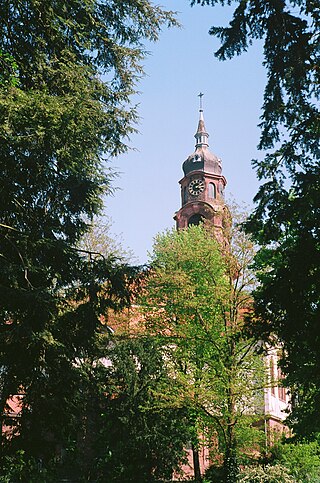
The Friedhof Rüppurr is a grave complex in the southern district of Rüppurr in the city of Karlsruhe in Baden-Württemberg. The cemetery area has a size of approx. 4.2 hectares and is laid out in the style of a rural cemetery.

The Hauptfriedhof in Karlsruhe is one of the oldest German communal rural cemeteries. In 1871, the first plans to build a new burial ground outside the city center began. The cemetery was laid out in 1874 by Josef Durm in the Rintheim district, east of the actual city, after the inner-city Alter Friedhof Karlsruhe in the Oststadt had become too small. The main cemetery has grown from its original size of 15.3 hectares in 1873 to over 34 hectares. The graves of more than 32,000 deceased are currently in the cemetery.
Jeff Stephan Klotz von Eckartsberg is a German writer, publisher, museum director and entrepreneur. He lives in Schloss Bauschlott where he runs the J. S. Klotz Verlagshaus. From 2009 to 2019 he was active in local politics in Remchingen. Jeff Klotz is above all active in various areas of the Protestant Church and welfare and social work, and runs the Protestant Academy Schloss Bauschlott. Since 2020 he has been a member of the State Synod of the Evangelischen Landeskirche in Baden and since 2021 also a member of the Synode der Evangelical Church in Germany (EKD).

Rintheim is a district of Karlsruhe. It is located between Hagsfeld in the north, Oststadt in the west and the Autobahn 5 in the east.
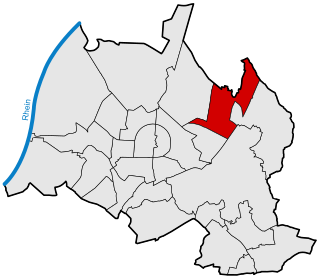
Hagsfeld is a borough in the north east of Karlsruhe. Hagsfeld borders the Stutensee borough of Blankenloch in the north, Weingarten in the northeast and the Karlsruhe boroughs Grötzingen in the east, Durlach in the southeast, Rintheim in the south and Waldstadt in the west.























